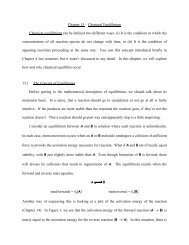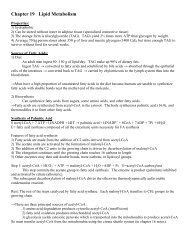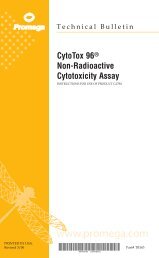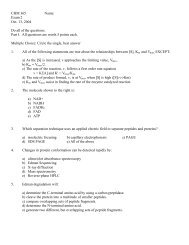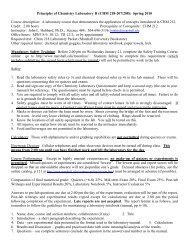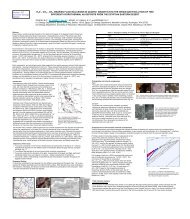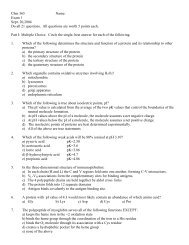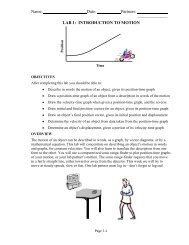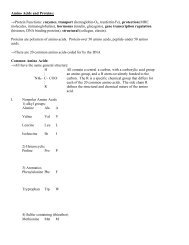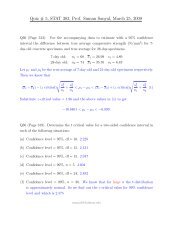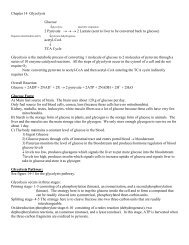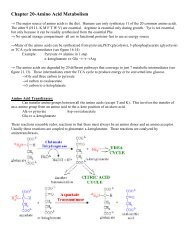Link to our lab as a pdf - College of Science - Marshall University
Link to our lab as a pdf - College of Science - Marshall University
Link to our lab as a pdf - College of Science - Marshall University
Create successful ePaper yourself
Turn your PDF publications into a flip-book with our unique Google optimized e-Paper software.
Forensic DNA Technology<br />
stabilizes the gel’s pH. This same solution is also<br />
used <strong>to</strong> submerge the gel, providing an electrically<br />
and chemically uniform medium for the process.<br />
Since the phosphate backbone <strong>of</strong> DNA only h<strong>as</strong> a<br />
negative charge in neutral <strong>to</strong> b<strong>as</strong>ic solutions, the<br />
solution is pH buffered <strong>to</strong> prevent it from becoming<br />
acidic, which would cause the DNA <strong>to</strong> reverse direction<br />
and move <strong>to</strong>ward the negative pole.<br />
Figure 2: gel visualization <strong>of</strong> genotypes.<br />
ing through the plants than do the larger fish. Both<br />
eventually get through, but the small one travels<br />
f<strong>as</strong>ter. Applying this analogy <strong>to</strong> a gel matrix, the<br />
DNA travels through a gel, and just <strong>as</strong> in the seaweed<br />
forest, smaller fragments travel f<strong>as</strong>ter than<br />
the larger. When, after a certain period <strong>of</strong> time, the<br />
electrical force that moves the DNA through the<br />
matrix is removed, the newly spread-out DNA fragments<br />
s<strong>to</strong>p moving. Their position in the gel is a<br />
direct relation <strong>to</strong> their size and they can be stained<br />
and their sizes compared <strong>to</strong> one another.<br />
Figure 2 is a schematic <strong>of</strong> a stained gel <strong>of</strong> each <strong>of</strong><br />
the f<strong>our</strong> possible genotypes <strong>of</strong> children from the<br />
mother and father in Figure 1. Notice how there is<br />
only one band for the homozygous genotype, C, because<br />
both the mother and father contributed the<br />
same allele. When visualized, this band should be<br />
darker than the other bands because there is twice<br />
<strong>as</strong> much DNA in that area <strong>as</strong> in the other bands.<br />
In electrophoresis, the solution used <strong>to</strong> create an<br />
agarose gel contains a salt dissolved in water, normally<br />
either Tris-acetate-EDTA (TAE) or Tris-borate-<br />
EDTA (TBE), that promotes electrical current and<br />
16<br />
Following separation by electrophoresis, fragments<br />
can be visualized by using several methods<br />
that directly bind <strong>to</strong> the DNA molecule. The most<br />
common in an educational setting is <strong>to</strong> stain with<br />
methylene blue. After electrophoresis, the gel is<br />
soaked in a stain solution. The stain adheres <strong>to</strong> the<br />
DNA molecules, but is also absorbed in<strong>to</strong> the pores<br />
<strong>of</strong> the gel. Because <strong>of</strong> this, the entire gel is blue until<br />
it is allowed <strong>to</strong> soak in clear water, which dilutes<br />
the stain absorbed in<strong>to</strong> the gel; a process called destaining.<br />
The dye bound <strong>to</strong> the DNA molecules is<br />
not removed during de-staining, and may be seen<br />
with the naked eye. In commercial and research<br />
settings, ethidium bromide is the most common<br />
nucleic acid stain. However, it can only be visualized<br />
under UV light and is mutagenic, which makes<br />
it unsuitable for novices. In this <strong>lab</strong>, a proprietary<br />
formula called BlueVis is used. BlueVis h<strong>as</strong> no special<br />
safety concerns and stains the DNA while it migrates<br />
on the gel, reducing the need for de-staining.<br />
Other visualization methods include radioactive<br />
<strong>lab</strong>els and commercially avai<strong>lab</strong>le fluorescent dyes<br />
which can be incorporated during the PCR process.<br />
To confirm the size <strong>of</strong> each PCR product, DNA size<br />
ladders are run on the same gel <strong>as</strong> the unknown<br />
samples. These ladders contain a series <strong>of</strong> known<br />
purified DNA fragments corresponding <strong>to</strong> most <strong>of</strong><br />
the known variant forms <strong>of</strong> each portion <strong>of</strong> target<br />
DNA; each variant form is called an allele. Therefore,<br />
these allelic ladders provide a means for determining<br />
the length, and thus the specific variant<br />
or allele type, <strong>of</strong> each amplified product for a given<br />
sample. Theoretically, a large number <strong>of</strong> alleles are<br />
possible for any given loci; however, generally only<br />
f<strong>our</strong> <strong>to</strong> ten alleles are common within a population.<br />
The alleles lengths that are present on the ladder,<br />
The Mystery <strong>of</strong> Lyle and Louise



